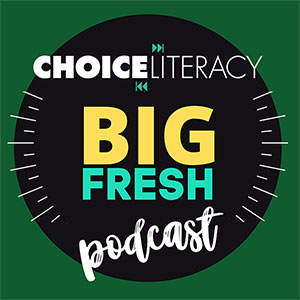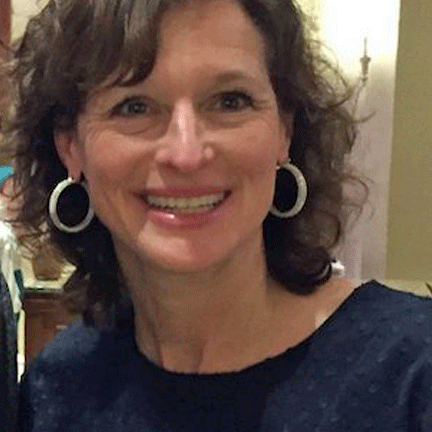In this podcast, Clare Landrigan and Tammy Mulligan, the founders of Teachers for Teachers, talk with Franki Sibberson about data. The challenge for teachers and schools is grappling with the mountain of data, using it wisely, and still finding room for creativity and balance in classrooms.
A full transcript of the podcast is available below the player.

Franki Sibberson: How can teachers use data in a way that’s balanced, in a way that doesn’t negate what we know about good instruction?
Clare Landrigan: Well, we hope that whenever we use data it’s going to be in a way that really helps us make our instruction more clear and more specific. But are seeing, in a lot of places, that that’s not always the case. One thing we think is really important is a term that we learned when we took a class called “Datawise” at Harvard. It’s called “Triangulating your Data” and it’s just a fancy term – although we like to say it – for making sure that we never judge a child on one data point, that we’re making sure at all times that when we’re talking about our learners and looking at instructions that we’re thinking about multiple data points on more than one assessment.
What we try to do is make sure that we balance those assessments between more formal assessments – that could be your state tests – or even we would consider formal to be those assessments that everybody gives at a certain time of year, your more formal assessment cycles, even if that’s a DRA or a Fountas & Pinnell or a DIBELS, you know, those assessment cycles that everyone goes through, that when we sit down to talk about those assessments, we’re also making sure that teachers are bringing the things that they’re using informally in their classroom every day, whether that’s their reading response notebooks, or conferring notes, or student writing samples.
We’re trying to say, “Okay, so this assessment says that a particular child is having difficulty with inferring, but okay, what’s happening every day in the classroom?” We really want to have that lens go across more than one piece. We find when we do that it really helps teachers on two points. One, we find it helps them become more specific, because when you just say a sentence like, “Kids are having trouble with inferring,” that’s really broad and it’s really hard to then take that information and then have it help you take action in your classroom. But when an assessment says you’re having trouble with inferring, and then you look at your classroom notes and you see what kids are doing, you can begin to say, “Oh, well, actually I do a pretty good job. We’re working on making predictions and they’re doing a pretty good job predicting and finding evidence in their text to support their prediction, but what we’re finding is they’re not changing and revising that prediction as they go through the text, as new evidence comes up.”
So now, all of a sudden, it’s gone from some huge piece to something very specific that, hey, I know how to teach that. So one, we think that’s really important. We also think when they use their classroom notes and kids’ work, it also helps them bring it more to their everyday work, as opposed to just one time a year on a test, that they can begin to see, “How can I use this information to help me teach tomorrow?” So we think that’s important.
The other thing is we think people should be meeting regularly around data and not just after the common assessment cycles, or after the big state test. We want teachers to see that this is important all the time, and that before a new unit of study, or when we’re confused about what we need to teach next, that we should be giving common assessments, we should be asking kids common questions, or having kids do something so that we can have their actual, authentic work, so that we can take a look at it and begin to think together about how we might list the quality of what they’re doing. So we want to make sure that this balance in the way that we look at data matches the way we’re teaching in our classrooms.
Franki Sibberson: Okay. There’s so much data right now. If the teacher feels buried in assessment data, what are some suggestions for beginning to use it to inform instruction?
Tammy Mulligan: Well, we do think lots of teachers feel buried in assessment data, when we see them bringing huge stacks to PLC meetings, and so it can be very overwhelming. So what we recommend people do is when it feels overwhelming, is to look at it with a lens, to have a question or have sort of a slice of things that you’re going to look at, so that you don’t have to digest it all at once. For example, we’ll have teachers bring the data, just look at the data of the children who didn’t do well on this assessment, who are at-risk readers in the classroom; let’s look at those. And actually we think that’s an important lens to look at, because fair isn’t equal and sometimes we need to spend more time looking at the data of our at-risk readers than we do of our typical readers, so that’s a great lens to look with.
We also think there are other lenses to look at. For example, if we notice, like Clare said, that a class is all having trouble with a particular comprehension issue, like inferring, as Clare mentioned, then what we can ask teachers to do is bring a range of data, bring kids who have performed at very different levels, and let’s just look at those children to see if we can see a pattern in the classroom. Sometimes, in state testing data, for example, kids will do poorly on one question, particularly open-response questions. Let’s look at ten kids’ assessment information on just that one question, and that really helps us to have that lens, so that people can be more specific. And once we’re successful at looking at the data with a particular lens, then it’s easier to move on and to look at it with a different question in mind.
Franki Sibberson: How can data analysis support teaching in a workshop setting?
Clare Landrigan: Well, we definitely see them going together. We think data analysis should enhance all instruction, but specifically, in a workshop setting, teachers who are teaching in a workshop structure, we think what’s most important is that structure really allows us to see the gradual release of responsibility. We see a pattern in schools that too many students have partial knowledge on many reading skills and strategies, but they’re not applying them independently, so we’re seeing teachers working very hard, but we’re not always seeing what the kids are doing with these strategies.
We feel like the workshop model really allows us to collect assessment data, but allows us to see what kids can do with a teacher, what kids can do with somewhat teacher support, and what kids can do on their own, so that we can begin to really become much more precise in our teaching. Sometimes when we take a step back and see, “So what is the child actually doing once I release this?” and they’re trying it on their own, we get a window into their confusions. You know, Marie Clay, I always go back to the beginning of learning how to analyze a running record, where they always taught you to look at what was right about what was wrong, and what the child was doing with their miscues. We feel like the workshop model really allows teachers that opportunity to see what’s right about what’s wrong. What are they actually confused about?
That point of confusion also has their window of understanding, and that’s where our teaching can become so much more precise, and we think the workshop really allows us to do that on a day-to-day basis, so that we’re not just waiting to see what they can do with us, and then letting them release once or twice a year on a formal assessment cycle. We also think that when we’re looking at data analysis for the workshop model, we can help teachers begin to look at patterns in their class, and begin to become more focused. So beginning to say, so what’s a couple things that your whole class needs to think about? What are some common patterns across the whole class, and that becomes often focus lessons.
We then want to say, “Now let’s look at some kids and think about, what are some pockets that might emerge for certain kids, where small group lessons begin to pop out?” We all have some learners that, depending on who they are and what they need, that some conferring, some one-on-one topics begin to emerge, so we also want them to begin to see their data and look for patterns to help make their instruction more cohesive and less overwhelming, when we’re thinking about a workshop structure.
Franki Sibberson: So with all the data available – and you touched on this a couple questions ago – but with all the data available to teachers, where should they begin? Where’s a good place for people to begin?
Tammy Mulligan: Well, we think actually taking a step back for a minute is a good place to begin, and that step back we refer to is assessment literacy. Sometimes when a new assessment comes into a district, there’s lots of professional development on administering the assessment, but there’s lots of professional development on what kinds of information you can glean from this assessment, and why are we giving it. Again, going back to that purpose for the assessment – why did we pick this assessment? What actually does this assessment help us to understand, and what doesn’t it do?
Once people understand that, then teachers can sort of think about that lens and think about, “Why were we giving it, and what information do I want to get out of this?” We also think teachers need to start with what’s interesting to them, thinking again about a particular set of children that have been struggling, a specific question, or type of skill. It also is a nice way to begin, to think about what time of year it is. If it’s the beginning of the year, we might look at student reading interviews and book blogs, and last year’s assessment results, to begin looking at assessment, and that helps us to get a frame of mind of who are the students in our classroom and what can we learn from that?
Franki Sibberson: And what about different times of the year?
Tammy Mulligan: We also want to take time in October or March, when there aren’t those assessment cycles that are coming up, to look at our conference notes, and student book logs, and student reading notebooks. That’s an important time to also look at assessment data as a group, and thinking about, so what are the teaching priorities that we see now?
Franki Sibberson: So is it possible to have too much data?
Clare Landrigan: It’s definitely possible to have too much data. Unfortunately, some schools have more control over this than others, to be totally honest, and we think it’s a real question. What we’re finding is, where in some districts where they don’t have time to teach, they’re so busy trying to assess, and so we have to be really careful not to over-assess our students and to really make sure that we have assessments that are providing us with information that we need.
We think the first step is to think a little bit, like Tammy said, take a step back and figure out, “Hold it. Why are we giving this assessment in the first place?” We try to work with schools to think about the full profile of the reader, and to think about what are all the areas that we need assessment data on, in terms of reading, and to begin to think about what assessments do we currently have. What we’re finding is that, in some districts, they have four assessments in one area but no assessments in another area, and beginning to take that step back and trying to balance our profile of assessments and thinking about, “Why are we giving it, and is it helping us?” Often new assessments are coming down the pike, new assessments are being sold, people are hearing they’re great and they most likely are great assessments.
But what’s happening is now they just have another assessment that’s teaching or giving them the same information that they already had, and that’s an issue, both for students and for teachers, because constantly trying to learn a new assessment is difficult to do, because it’s a whole new way of looking at things, and then we have to learn how to analyze. So that’s one issue we’re seeing, and it’s also thinking about, how are we going to start to make some choices so that everybody doesn’t have to be having everything?
What we mean by that is, we don’t think fair is equal, and some students need more assessments and some students need less. We have some students who are coming in and at the beginning of kindergarten are being given an assessment, and they’re showing us that they’re already at the end of the year, yet they have to sit through that same assessment mid-year and end of year. We think we have to start questioning, “Is that the best use of the teacher and the student’s time, or is there a different assessment that would be better for that child?”
So helping districts make a common assessment plan, and making some decisions about, what are some assessments that we need on every student at certain times of the year, why do we need that, and being clear about our purpose, because sometimes our purpose is for administrators. It is because we need to know how many kids are at risk in our district, because we’re making financial decisions, and we need to know that. But we find it helpful when teachers at least know why they’re doing that, because honestly, at the end of the year, it’s not informing their instruction. At least if they know that’s why, that’s helpful, and the end, then thinking about, “Well, how do we take that and give it to the next year’s teacher,” so that even though it’s not a perfect way to inform your instruction because we know it’s a little old, it’s at least something, to get us started.
So beginning to think about K-5, and beginning to think about that full profile, we find is helpful, but mostly, really pushing people to think about, “Why am I giving this assessment? How is it helping me?” and really pushing back when we’re giving an assessment that isn’t actually helping us or giving us the information we need.
Franki Sibberson: Okay. And the last question I have is how do teachers balance the data analysis needs with the time needed to actually use the data to plan for instruction?
Tammy Mulligan: Well, we see that data analysis and planning for instructions are linked together. When we’re planning lessons with teachers, we rarely plan a lesson without looking at the data, and when we’re looking at the data, we’re always planning lessons. We think that those two should always be linked together. We’re seeing that the data is really helping instruction and it’s helping us to plan lessons that are more specific, that teachers are then pinpointing what is the actual strategy that that child needs some support with. What we find, though, with data analysis is that what’s happening sometimes in districts is teachers are being told what the data says rather than constructing it.
What we want are teachers to be able to sit around with the data and use protocols, and think about, as they’re looking at the data, what do they notice in the data? What questions do they have? Because when they’re part of constructing what the data says, then they have ownership over the data, and they can really pinpoint what actually needs to be planned. We want them to be able to have time to look at that data and construct, “What’s important here? What do we need to teach?”




